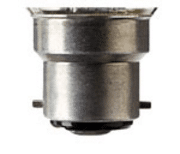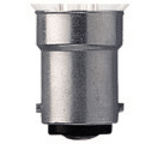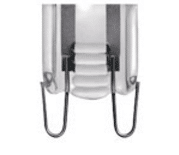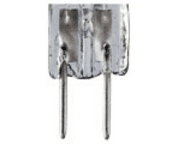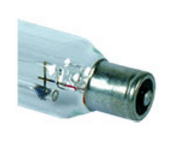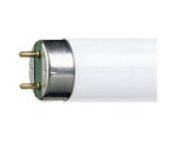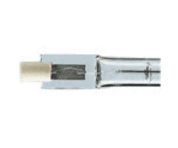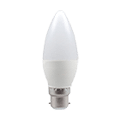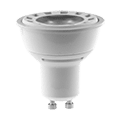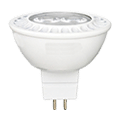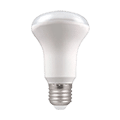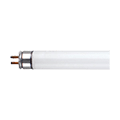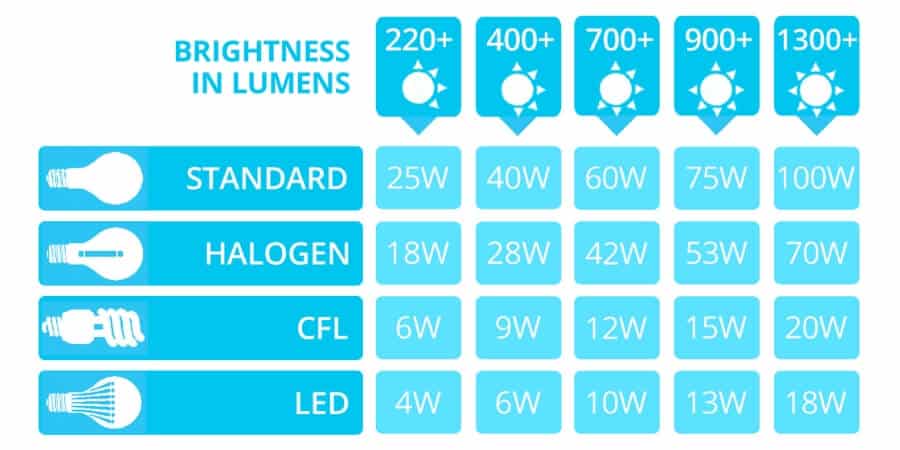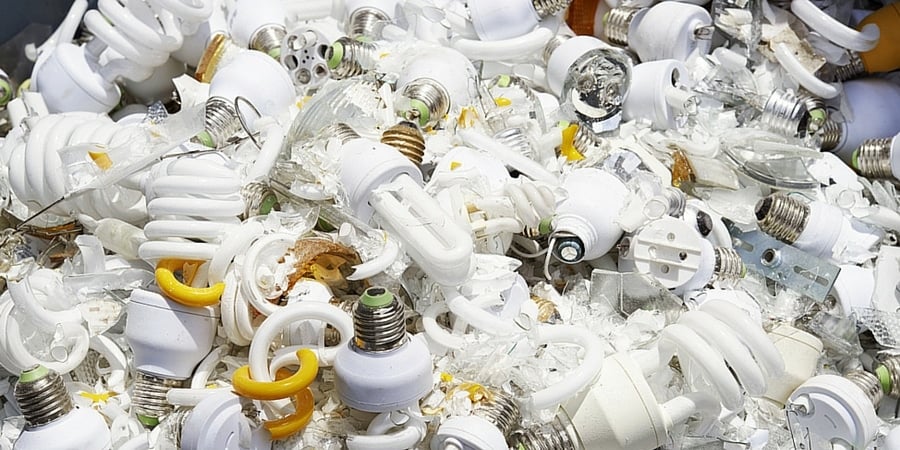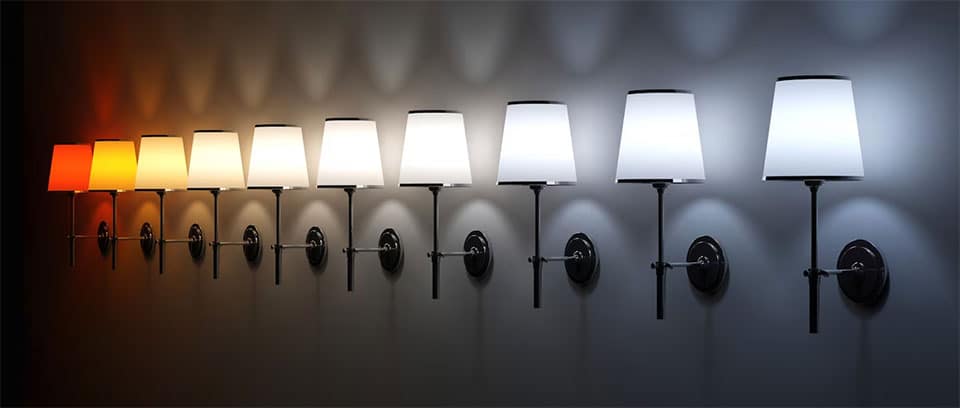Accent Lighting
Directional lighting to emphasize a particular object or draw attention to a display item.
Ambient Lighting
The general lighting present in an area –excluding task lighting and accent lighting but including general lighting and daylight streaming in.
Amperes
(“Amps.”) A measure of electrical current. In incandescent lamps, the current is related to voltage and power as follows: Watts (power) = Volts x Amps (current).
Application
Also called “lighting application”, it refers to the particular use the lamp is being put to. (e.g. high-bay industrial application or retail lighting application.) The term can also refer in a general way to “application engineering” which deals with specific parameters and usage of light sources. (e.g. how to do a lighting layout, where to place fixtures and so on.)
Arc
A general term for a high intensity electrical discharge occurring between two electrodes in a gaseous medium, usually accompanied by the generation of heat and the emission of light (See ELECTRICAL DISCHARGE).
Arc Lamp
A light source containing an arc (see above). Also called a discharge lamp, or an arc discharge lamp (See ELECTRICAL DISCHARGE).
Application
Also called “lighting application”, it refers to the particular use the lamp is being put to. (e.g. high-bay industrial application or retail lighting application).
Average Rated Life (ARL)
Lifetime quoting the estimated time it would take for 50 percent of the bulbs to fail.
B15
A 15mm Push and Twist Small Bayonet Cap. Also known as as SBC Cap.
B22
A 22mm Push and Twist Bayonet Cap. Also known as as BC Cap.
Ballast
An auxiliary piece of equipment required to start and to properly control the flow of current to gas discharge light sources such as fluorescent and high intensity discharge (HID) lamps.
Base or Socket
The socket is the receptacle connected to the electrical supply; the base is the end of the lamp that fits into the socket. There are many types of bases used in lamps, screw and bayonet bases being the most common for traditional lightbulbs, while bipin bases are common for linear fluorescent lamps.
Base Temperature (Maximum)
The maximum operating temperature permitted for the base in Celsius. Fixture manufacturers need to ensure that these conditions are satisfied in their fixture.
Bayonet
A style of bulb base which uses keyways instead of threads to connect the bulb to the fixture base. The bulb is locked in place by pushing it down and turning it clockwise.
Beam Angle
Sometimes referred to as “beam spread”, measures how light is distributed from the source of illumination onto a target area. (See FIELD ANGLE).
Beam Lumens
The total lumens present within the portion of the beam contained in the beam angle.
Beam Spread (Approximate)
For reflector type lamps. The total angle of the directed beam (in degrees horizontal or vertical) to where the intensity of the beam falls to 50% or 10% of the maximum candlepower value as indicated.
Bi-Pin
Any base with two metal pins for electrical contact.
Black Light
A popular term referring to a light source emitting mostly near UV (320 to 400 nm) and very little visible light.
Blackbody
A hot body with an incandescent black surface at a certain temperature used as a standard for comparison. Note that a black surface is the best radiator possible. A tungsten filament will emit slightly less radiation than a blackbody at the same temperature.
Brightness
Brightness can refer to any of several technical terms used in lighting and is, therefore, ambiguous (See LUMINANCE).
Bulb
A loose way of referring to a lamp. “Bulb” refers to the outer glass bulb containing the light source.
Candela (CD)
The measure of luminous intensity of a source in a given direction. The term has been retained from the early days of lighting when a standard candle of a fixed size and composition was defined as producing one candela in every direction. A plot of intensity versus direction is called a candela distribution curve and is often provided for reflectorized lamps and for luminaires with a lamp operating in them.
Candle
A lightbulb that emulates the shape of a candle flame.
Ceramic Metal Halide (CMH®)
A type of metal halide lamp that uses a ceramic material for the arc tube instead of glass quartz, resulting in better colour rendering (>80 CRI) and improved lumen maintenance. GE ConstantColor® CMH® lamps feature a 3-piece arc tube design that delivers excellent colour consistency and lamp reliability.
Chromaticity
Measure to identify the colour of a light source, typically expressed as (x,y) coordinates on a chromaticity chart (See COLOR TEMPERATURE).
COB LED
Short for Chip On Board. LED chips are mounted directly on to a substrate.
Colour Rendering Index (CRI)
An international system used to rate a lamp’s ability to render object colours. The higher the CRI (based upon a 0-100 scale) the richer colours generally appear. CRI ratings of various lamps may be compared, but a numerical comparison is only valid if the lamps are close in colour temperature. CRI differences among lamps are not usually significant (visible to the eye) unless the difference is more than 3-5 points.
Colour Rendering Indicator
Draws attention to the fact that this is a lamp with high colour rendering, which helps objects and persons illuminated to appear more true to life.
Colour temperature
Temperature of the black body that emits radiation of the same chromaticity as the radiation considered. Unit Kelvin, K.
Colour Temperature (Correlated Colour Temperature – CCT)
Measured in Kelvins, CCT represents the tone of white the light source emits. The lower the Kelvin the yellower the hue, the higher the kelvin the bluer the hue, for instance colour 2700 kelvin would be warm, inviting light whereas 6500k would be a fresh invigorating daylight light (See CHROMATICITY).
Compact Fluorescent Lamp (CFL)
The general term applied to fluorescent lamps that are single-ended and that have smaller diameter tubes that are bent to form a compact shape.
Cool Beam
A light that directs the heat backwards.
Cool White
A term used to denote a colour temperature of around 4000k.
Cosine-Corrected
An illuminance meter that measures the light level correctly irrespective of the angle the light is coming from. (See ILLUMINANCE METER)
Crown Silver
A lightbulb that reflects light backwards into the fitting, making them ideal for use in locations where the bulb is visible but a barrier is needed to stop glare from the filament.
Current Type (AC/DC)
Whether the operational voltage is based on Alternating Current or Direct Current.
Daylight Harvesting
Lighting design for building interiors that makes use of daylight as a way of reducing energy consumption.
Daylight Lamp
A lamp resembling the colour of daylight, typically with a colour temperature of 5500 K to 6500K
Dichroic Reflector (or Filter)
A reflector (or filter) that reflects one region of the spectrum while allowing the other region(s) to pass through. A reflector lamp with a dichroic reflector will have a “cool beam” i.e. most of the heat has been removed from the beam by allowing it to pass through the reflector while the light has been reflected.
Dimmable
Whether or not the lamp lumens can be varied while maintaining reliability.
Dimmer, Dimming Control
A device used to lower the light output of a source, usually by reducing the wattage it is being operated at. Dimming controls are increasing in popularity as energy conserving devices.
Discharge lamp
Lamp in which the light is produced, directly or indirectly, by an electric discharge through a gas, a metal vapor, or a mixture of several gases and vapors.
Downlight
Luminaire concentrating the light, usually recessed in the ceiling.
E27
A 27mm Edison screw Cap. Also known as an ES Cap.
E40
A 40mm Edison screw Cap. Also known as an GES Cap.
ECE R37 Code
European Common Market Regulation 37 standard lamp number.
Edison Screw
A 27mm Edison screw Cap. Also known as an E27 ES Cap.
Efficacy
A measurement of how effective the light source is in converting electrical energy to LUMENS of visible light. Expressed in LUMENS-PER-WATT (LPW) this measure gives more weight to the yellow region of the spectrum and less weight to the blue and red region where the eye is not as sensitive.
Efficiency
The efficiency of a light source is simply the fraction of electrical energy converted to light, i.e. watts of visible light produced for each watt of electrical power with no concern about the wavelength where the energy is being radiated. For example, a 100 watt incandescent lamp converts 7% of the electrical energy into light; discharge lamps convert 25% to 40% into light. The efficiency of a luminaire or fixture is the percentage of the lamp lumens that actually comes out of the fixture (See LUMINOUS EFFICACY).
Electrical Discharge
A condition under which a gas becomes electrically conducting and becomes capable of transmitting current, usually accompanied by the emission of visible and other radiation. An electric spark in air is an example of an electrical discharge, as is a welder’s arc and a lightning bolt. (See ARC, ELECTRODELESS LAMPS)
Electromagnetic Ballast
A ballast used with discharge lamps that consists primarily of transformer-like copper windings on a steel or iron core (See ELECTRONIC BALLASTS).
Electromagnetic Inference (EMI)
High frequency electronic ballasts and other electronic devices can produce a small amount of radio waves which can interfere with radio and TV. Federal mandated requirements must be met for EMI levels before an electronic device is considered FCC compliant. (FCC is the Federal Communications Commission.)
Electronic Ballast
A short name for a fluorescent high frequency electronic ballast. Electronic ballasts use solid state electronic components and typically operate fluorescent lamps at frequencies in the range of 25-35 kHz. The benefits are: increased lamp efficacy, reduced ballast losses and lighter, smaller ballasts compared to electromagnetic ballasts. Electronic ballasts may also be used with HID (high intensity discharge) lamps.
Emergency Lighting
Lighting provided for use when the supply to the normal lighting fails.
Enclosed Fixtures
A light fixture that has a tight seal around the light source (See OPEN FIXTURE RATED).
Equivalent Wattage
The amount of light output produced by the light source, not to be confused with the wattage that is consumed. For example a 9watt LED with an 806 lumen output, only consumes 9watts but provides the equivalent wattage of a 60watt incandescent lightbulb.
Festoon
Rope or string lighting, often used for external decorative lighting.
Filament Design
Filaments are designated by a letter combination in which C is a coiled wire filament, CC is a coiled wire that is itself wound into a larger coil, and SR is a straight ribbon filament. Numbers represent the type of filament-support arrangement.
Filament LED
LED filament light bulbs are built to look like traditional carbon filament or traditional incandecescent light bulbs. Often used in exposed or decoratitve fittings.
Fire rated fitting
A fitting that has been designed to stop the passage of smoke and flames in the ceiling.
Fixture Requirements
Describes fixture requirements for HID lamps.
O = Open or Enclosed Fixtures
E = Enclosed Fixtures Only
S = Lamps operated in a vertical position (Base Up or Down) ±15°, can be used in an open fixture. Lamps burned in any other orientation must be used in “enclosed fixtures only.” See additional details in the e-Catalogue Help Menu under the HID category.
Flicker
The periodic variation in light level caused by AC operation that can lead to strobe effects.
Flood
Used to refer to the beam pattern of a reflector lamp, which disperses the light over a wide beam angle, typically 20 degrees or more. (“Flood” as opposed to “spot”)
Floodlight
A luminaire used to light a scene or object to a level much brighter than its surroundings. Usually floodlights can be aimed at the object or area of interest.
Fluorescent
A low-pressure mercury vapor gas discharge lamp.
Fluorescent Lamp
A high efficiency lamp utilizing an electric discharge through low pressure mercury vapor to produce ultraviolet (UV) energy. The UV excites phosphor materials applied as a thin layer on the inside of a glass tube which makes up the structure of the lamp. The phosphors transform the UV to visible light.
Footcandle
(fc) A unit of illuminance or light falling onto a surface. It stands for the light level on a surface one foot from a standard candle. One footcandle is equal to one lumen per square foot. See also Lux.
Footcandle Meter
(See ILLUMINANCE METER).
Frequency (Nominal Operations)
The stated operating frequency in Hz of a discharge lamp.
Full Spectrum Lighting
A marketing term, typically associated with light sources that are similar to some forms of natural daylight (5000K and above, 90+ CRI), but sometimes more broadly used for lamps that have a smooth and continuous colour spectrum.
G13
A two pin fitting located at each of the tube with 13mm between the two pins. The T8 (26mm diameter) and T12 (38mm diameter) use the G13 cap fitting.
G4
A push in 2 pin cap with 4mm between the pins.
G5
A two pin fitting located at each of a tube with 5mm between the two pins. The T5 (16mm tube diameter) and T4 (12mm tube diameter) use the G5 cap fitting.
G9
A push in cap with 2 pins measuring 9mm apart, with a similar to the appearance of paperclips.
GES
A 40mm Giant Edison screw Cap. Also known as an E40 Cap.
Glare
Visual discomfort caused by excessive brightness is called discomfort glare. If task performance is affected it is called disability glare. Glare can be direct glare or indirect (reflected) glare (See VEILING REFLECTION and VISUAL COMFORT PROBABILITY).
Golfball
Golf ball shaped lightbulbs, normally 45mm in diameter.
GR10q
A 4pin base type commonly found on 2D compact fluorescent and LED lamps.
GR8
The GR8 base type is a 2 pin cap with 8mm between the pins. Found on 2D Square lightbulbs.
GU10
A twist and Lock 2 Prong cap with 10mm between the pins.
GU4
A push in 2 pin cap with 4mm between the pins.
GU5.3
A push in 2 pin cap with 5.3mm between the pins.
GY6.35
A push in 2 pin cap with 6.35mm between the pins.
GZ10
A twist and Lock 2 Prong cap with 10mm between the pins. Similar to a GU10 cap but with straight edges rather than bevelled edges. A GZ10 will not fit into a GU10 socket whereas a GU10 will fit into a GZ10 socket.
Halogen Lamp
A halogen lamp is an incandescent lamp with a filament that is surrounded by halogen gases, such as iodine or bromine. Halogen gases allow the filaments to be operated at higher temperatures and higher efficacies. The halogen participates in a tungsten transport cycle, returning tungsten to the filament and prolonging lamp life.
Halogen-IR (HIR) Lamp
GE designation for high-efficiency tungsten halogen lamps. HIR lamps utilize shaped filament tubes coated with numerous layers of materials that transmit light but reflect the heat (infrared) back into the filament. This reduces the power needed to keep the filament hot.
Heat Sink
Also known as a heat exchanger. Used to absorb thermal energy from an LED.
High Intensity Discharge (HID) Lamp
A general term for mercury, metal halide and high-pressure sodium lamps. HID lamps contain compact arc tubes which enclose various gases and metal salts operating at relatively high pressures and temperatures.
High-Bay Lighting
Lighting designed for (typically) industrial locations with a ceiling height of 25 feet and above.
High-Pressure Sodium (HPS) Lamp
HPS lamps are high intensity discharge light sources that product light by an electrical discharge though sodium vapor operating at relatively high pressures and temperatures.
Hot Restart Time
Time it takes for a High Intensity Discharge lamp to reach 90% of light output after going from on to off to on.
Ignitor
An electronic device providing a high voltage pulse to initiate an electrical discharge. Typically, the ignitor is paired with or is a part of the ballast (See STARTER).
Illuminance
The “density” of light (lumens/area) incident on a surface; i.e. the light level on a surface. Illuminance is measured in footcandles or lux.
Illuminance Meter
A device that measures the illuminance at a location calibrated either in footcandles or in lux. (Also known as a light meter — See COSINE CORRECTED)
Incandescent Lamp
A light source that generates light utilizing a thin filament wire (usually of tungsten) heated to white heat by an electric current passing through it.
Indirect Lighting
The method of lighting a space by directing the light from luminaires upwards towards the ceiling. The light scattered off the ceiling produces a soft, diffuse illumination for the entire area.
Induction Lighting
Gases can be excited directly by radio-frequency or microwaves from a coil that creates induced electromagnetic fields. This is called induction lighting and it differs from a conventional discharge, which uses electrodes to carry current into the arc. Induction lamps have no electrodes inside the chamber and generally, therefore, have longer life than standard lamps. Genura® is an example of an induction lamp.
Infrared Radiation
Electromagnetic energy radiated in the wavelength range of about 770 to 1,000,000 nanometers. Energy in this range cannot be seen by the human eye, but can be sensed as heat by the skin.
Instant Start
A type of ballast designed to start fluorescent lamps as soon as the power is applied. Most T8 fluorescent lamps are being operated on electronic instant-start ballasts. Slimline fluorescent lamps operate only on instant start circuits (See RAPID START).
IP Rating
The Ingress Protection (IP) rating refers to the degree of protection an electrical enclosure can provide against the intrusion of solid objects, including body parts like hands and fingers, dust, accidental contact, and water.
Isolux Plot (or Isofootcandle Plot)
A line plotted to show points of equal illuminance (lux or footcandles) on a surface illuminated by a source or sources.
Kelvin
The unit Colour Correlated Colour temperature (CCT) is measured in denoting the colour produced from of a light source. Shown as a “K” rating, for instance 4000k is know as cool white. The lower the K rating the warmer/yellower the hue, the higher the K rating, the bluer/cooler the hue.
Kilowatt
(kW) The measure of electrical power equal to 1000 watts.
Kilowatt Hour
(kWh) The standard measure of electrical energy and the typical billing unit used by electrical utilities for electricity use. A 100-watt lamp operated for 10 hours consumes 1000 watt-hours (100 x 10) or one kilowatt-hour. If the utility charges £0.10/kWh, then the electricity cost for the 10 hours of operation would be 10p (1 x £0.10)
L70/L80/L90
The minimum amount of lumens the light source will emit at the rated life. For instance if an LED lamp had a life of 25,000 hours and an L70 rating it would mean that 70 percent of the initial lumens were emitted at 25,000 hours.
Lamp
The term used to refer to the complete light source package, including the inner parts as well a the outer bulb or tube. “Lamp”, of course, is also commonly used to refer to a type of small light fixture such as a table lamp.
Lamp Height
Referenced by IEC as Dimension C. Also referred to as “Base Face to Top of Lamp”.
Lamp Width
Referenced by IEC as Dimension A.
LED Retrofit
An LED designed to mimic a tradtional light source and which fits into the existing fitting.
Lens
A transparent or semi-transparent element which controls the distribution of light by redirecting individual rays. Luminaires often have lenses in addition to reflectors.
Light
Radiant energy that can be sensed or seen by the human eye. Visible light is measured in lumens.
Light Emitting Diode (LED)
A semiconductor light source that emits light when current flows through it.
Light Loss Factor
The product of all factors that contribute to lowering the illumination level including reflector degradation, dirt, lamp depreciation over time, voltage fluctuations, etc.
Light Meter
(See ILLUMINANCE METER)
Light Pollution
Light that is directed to areas where it is not needed, and thereby interferes with some visual act. Light pollution directed or reflected into the sky creates a “dome” of wasted light and makes it difficult to see stars above cities.
Light Trespass (Spill Light)
Light that is not aimed properly or shielded effectively can spill out at into areas that don’t want it: it can be directed towards drivers, pedestrians or neighbours. It is distracting and annoying and can sometimes be disabling.
Lighting Industry Federation (LIF) Code
For Showbiz/Specialty lamps, these are assigned by the Lighting Federation of London U.K. They ensure electrical and mechanical interchangeability of similarly coded lamps. LIF codes are divided into groups according to the primary application of the lamps.
Lumen Maintenance
A measure of how well a lamp maintains its light output over time. It may be expressed numerically or as a graph of light output vs. time.
Lumens
A measure of the luminous flux or quantity of light emitted by a source. For example, a dinner candle provides about 12 lumens. A 60-watt Soft White incandescent lamp provides about 840 lumens.
Luminaire
A complete lighting unit consisting of a lamp (or lamps), ballast (or ballasts) as required together with the parts designed to distribute the light, position and protect the lamps and connect them to the power supply. A luminaire is often referred to as a fixture.
Luminaire Efficiency
The ratio of total lumens emitted by a luminaire to those emitted by the lamp or lamps used in that luminaire.
Luminance
A measure of “surface brightness” when an observer is looking in the direction of the surface. It is measured in candelas per square meter (or per square foot) and was formerly referred to as “photometric brightness”.
Luminous Efficacy
(See EFFICACY)
Lux (lx)
A unit of illuminance or light falling onto a surface. One lux is equal to one lumen per square meter. Ten lux approximately equals one footcandle. (See FOOTCANDLE)
Maximum Overall Length (M.O.L.)
The end-to-end measurement of a lamp, expressed in inches or millimeters.
Mean Lumens
The average light output of a lamp over its rated life. Based on the shape of the lumen depreciation curve, for fluorescent and metal halide lamps, mean lumens are measured at 40% of rated lamp life. For mercury, high-pressure sodium and incandescent lamps, mean lumen ratings refer to lumens at 50% of rated lamp life (See LUMEN MAINTENANCE).
Mercury Lamp
A high-intensity discharge light source operating at a relatively high pressure (about 1 atmosphere) and temperature in which most of the light is produced by radiation from excited mercury vapor. Phosphor coatings on some lamp types add additional light and improve colour rendering.
Metal Halide Lamp
A high intensity discharge light source in which the light is produced by the radiation from mercury, plus halides of metals such as sodium, scandium, indium and dysprosium. Some lamp types may also utilize phosphor coatings. GE trade names include: Multi-Vapor®, ConstantColor® CMH®, PulseArc®, Staybright®, Watt-Miser®, ChromaFit and Arcstream®.
Monochromatic Light
Light with only one wavelength (i.e. colour) present.
Mounting Height
Distance from the bottom of the fixture to either the floor or work plane, depending on usage.
MR-16 and MR-11
A line of low voltage compact reflector lamps used for accent and spot lighting. The 16 and 11 refer to 16 eighths of an inch diameter and 11 eighths.
Multi-Vapor®
A GE brand for metal halide lamps.
Nanometer
A unit of wavelength equal to one billionth of a meter.
Open Circuit Voltage (OCV)
Open Circuit Voltage measured across the socket the lamp screws into, with the ballast powered on. It is dangerous to stick a voltmeter into such a socket without precise knowledge of the ballast because exceedingly high voltages could be present.
Open Fixture Rated
Lamps that are approved for burning in open fixtures (as opposed to enclosed fixtures which have an acrylic lens or plate glass enclosure).
Operating Position or Burn Position
Mercury and High Pressure Sodium lamps may be operated in any burn position and will still maintain their rated performance specifications. Metal Halide and Low Pressure Sodium lamps, however, are optimized for performance in specific burn positions, or may be restricted to certain burn positions for safety reasons.
U = Universal burning position
HBU = Horizontal -15° to Base Up
HBD = Horizontal +15° to Base Down
HOR = Horizontal ±15°
H45 = Horizontal to -45° only
VBU = Vertical Base Up ±15°
VBD = Vertical Base Down ±15°
If no special burn position is noted, the burn position is universal.
Operating Voltage
For electrical discharge lamps, this is the voltage measured across the discharge when the lamp is operating. It is governed by the contents of the chamber and is somewhat independent of the ballast and other external factors.
PAR Lamp
PAR is an acronym for parabolic aluminized reflector. A PAR lamp, which may utilize either an incandescent filament, a halogen filament tube or a HID arc tube, is a precision pressed-glass reflector lamp. PAR lamps rely on both the internal reflector and prisms in the lens for control of the light beam.
Phosphor
An inorganic chemical compound processed into a powder and deposited on the inner glass surface of fluorescent tubes and some mercury and metal-halide lamp bulbs. Phosphors are designed to absorb short wavelength ultraviolet radiation and to transform and emit it as visible light (See FLOURESCENCE).
Photocell
A sensor that allows you to detect light.
Photometry
The measurement of light and related quantities.
Photopic
Vision for which the cones in the eye are responsible; typically at high brightness and in the foveal or central region (See SCOTOPIC, FOVEA, FOVEAL VISON).
Power Factor (PF)
A measure of the phase difference between voltage and current drawn by an electrical device, such as a ballast or motor. Power factors can range from 0 to 1.0, with 1.0 being ideal. Power factor is sometimes expressed as a percent. Incandescent lamps have power factors close to 1.0 because they are simple “resistive” loads. The power factor of a fluorescent and HID lamp system is determined by the ballast used. “High” power factor usually means a rating of 0.9 or greater. Power companies may penalize users for using low power factor devices.
Projector
Luminaire using reflection and/or refraction to increase the luminous intensity within a limited solid angle.
Pulse Start
An HID ballast with a high voltage ignitor to start the lamp.
Pygmy
Also know as Sign Lightbulbs, they are a compact lightbulb perfect fittings where space is key.
Quartz
A name for fused silica or melted sand from which many high-temperature containers are fashioned in the lighting industry. Quartz looks like glass but can withstand the high temperatures needed to contain high intensity arc discharges.
Quartz-Halogen Lamp
(See HALOGEN LAMPS).
R7s
The R7S base has ceramic ends with a 7mm diameter contact point.
RA Rating
Provides information about the quality of the color rendering of a light source.
Rated Lamp Life
For most lamps types, rated life is the point that 50 percent of the lamps would have failed. For LED, L70, L80, and L90 ratings are used, and is used to describe the minimum amount of lumens the light source will emit at the rated life, for instance L70 would mean that 70 percent of the initial lumens were emitted.
Reflector Lamp (R)
A light source with a built-in reflecting surface. Sometimes, the term is used to refer specifically to blown bulbs like the R and ER lamps; at other times, it includes all reflectorized lamps like PAR and MR.
RGB
Short for Red, Green and Blue. A light source capable of changing colour.
S15
The S15 cap is found on both ends of a double ended strip light and has a 15mm diameter.
Screw-In
Edison Screw E27/ES, Small Edison Screw E14/SES, Candelabra screw E12/CES, Minituare Edison Screw E10/MES.
Seal Temperature (Maximum)
The maximum operating temperature of the seal of the lamp in Celsius.
Self-Ballasted Lamps
A discharge lamp with an integral ballasting device allowing the lamp to be directly connected to a socket providing line voltage (See CFL).
SES
A 14mm small Edison screw Cap. Also known as an SES Cap.
Smart lighting
A light source that can either be connected through Wi-fi or other Bluetooth-enabled devices. The connectivity feature allows users to control the features of the light source via an app on their smartphone, tablet or voice controlled devices.
SMD LED
Short for Surface Mounted Device. LED chips that are mounted onto a PCB.
Spacing to Mounting Height Ratio
Ratio of fixture spacing (distance apart) to mounting height above the work plane; sometimes called spacing criterion. It is OK to have fixture spaced closer than the spacing criterion suggested by the manufacturer but not farther, or you will get dark spots in-between fixtures.
Spectral Power Distribution (SPD)
A graph of the radiant power emitted by a light source as a function of wavelength. SPDs provide a visual profile or “finger print” of the colour characteristics of the source throughout the visible part of the spectrum.
Spot
A colloquial term referring to a reflector lamp with a tight beam of light, typically around 10 degrees or less. It comes from the fact that such a lamp produces a narrow spot of light as opposed to a wide flood of light.
Starter
An electronic module or device used to assist in starting a discharge lamp, typically by providing a high-voltage surge (See IGNITOR).
Starting Temperature (Minimum)
The minimum ambient temperature at which the lamp will start reliably.
System
A term referring to the lamp and ballast combination, and sometimes to the entire lighting delivery system including the fixture, the optics, the particular layout and the lighting controls.
T12, T9, T8, T5, T4, T2
A designation for the diameter of a tubular bulb in eighths of an inch; T12 is 12 eighths of an inch, T-8 is 1 inch, and so on. T12 is 38mm, T9 is 29mm, T8 is 26mm, T5 is 16mm, T4 is 12mm and T2 is 7mm.
Task Lighting
Supplemental lighting provided to assist in performing a localized task, e.g. a table lamp for reading or an inspection lamp for fabric inspection.
Tungsten-Halogen Lamp
(See HALOGEN LAMP).
Underwriters Laboratories (UL)
A private organization which tests and lists electrical (and other) equipment for electrical and fire safety according to recognized UL and other standards. A UL listing is not an indication of overall performance. Lamps are not UL listed except for compact fluorescent lamp assemblies – those with screw bases and built-in ballasts.
Volt
A measure of “electrical pressure” between two points. The higher the voltage, the more current will be pushed through a resistor connected across the points. The volt specification of an incandescent lamp is the electrical “pressure” required to drive it at its designed point. The “voltage” of a ballast (e.g. 277 V) refers to the line voltage it must be connected to.
Voltage
A measurement of the electromotive force in an electrical circuit or device expressed in volts. Voltage can be thought of as being analogous to the pressure in a waterline.
W.E.E.E
Waste Electrical and Electronic Equipment (WEEE) Directive is legislation for the disposal of electronic waste.
Wall Temperature (Maximum Bulb)
The maximum operating bulb wall temperature in Celsius.
Warm Up Time to 90%
The time it takes for a High Intensity Discharge lamp to reach 90% of light output after being turned on.
Warm White
Refers to a colour temperature around 3000K, providing a yellowish-white light.
Watt
A unit of electrical power. Lamps are rated in watts to indicate the rate at which they consume energy (See KILOWATT HOUR).
Wattage Indicator Reduced
Indicates that this is a reduced wattage option for lamps normally used in this application. Be sure to check wattage, lumens and life to determine which lamp is best suited to your needs.
Wavelength
The distance between two neighbouring crests of a travelling wave. The wavelength of light is between 400 and 700 nanometers.
Work Plane
Plane at which work is done and at which illumination is specified and measured; unless otherwise indicated, it is assumed to be a horizontal plane 30 inches above the floor (table-top height) having the same area as the floor.
Working Distance (Typical)
For Multi-Mirror® and other reflector Quartzline® lamps and MARC™ Projection lamps, the Working Distance shown is the distance from the front surface of the reflector rim to the film plane, in the optical system for which the lamp was first designed. In most cases, it provides a uniform plane of light for the intended aperture.
The Lightbulb Company (UK) Ltd acknowledges the copyright of Philips Lighting B.V. as the source for this glossary.


